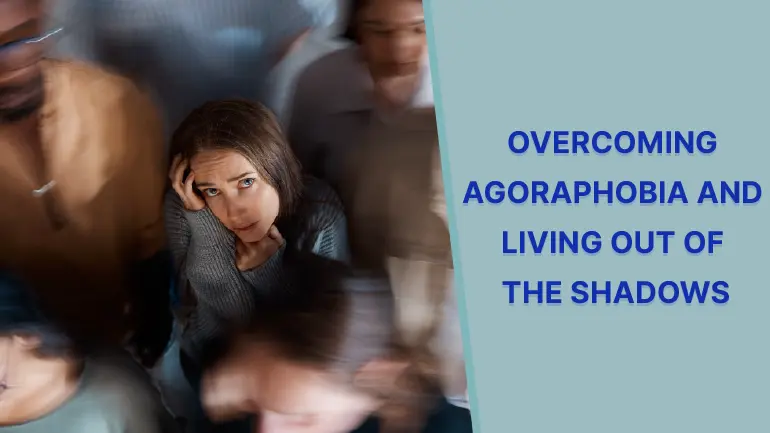Introduction
Agoraphobia is an anxiety disorder characterized by a fear of spaces, crowds and situations that can trigger panic or embarrassment. People, with agoraphobia often struggle to leave their comfort zones. May avoid places or activities they perceive as threatening. This condition can have an impact on their lives limiting their social interactions and independence. In this article we will explore the causes, symptoms and available treatment options for agoraphobia in order to provide an understanding of this debilitating condition.
What is Agoraphobia?
Agoraphobia is an anxiety disorder where individuals experience fear and actively avoid places or situations that may lead to panic feelings of being trapped, helplessness or embarrassment. This condition is marked by an uneasiness related to both real life scenarios and anticipated circumstances such as using transportation being in open or enclosed spaces being amongst crowds or waiting in lines.
The anxiety associated with agoraphobia stems from the fear of not being able to escape or receive assistance if overwhelming anxiety arises. Situations may be avoided due to concerns about getting lost falling down or not having access, to restrooms.
Agoraphobia often develops when individuals have gone through one or more panic attacks causing them to worry about having attacks and subsequently avoiding the places where they might happen.
People, with agoraphobia commonly find it challenging to feel safe in any setting in locations where large groups gather or in unfamiliar environments. The fear can become so overwhelming that individuals may feel trapped in their homes and rely on the presence of someone they trust like a family member or friend to accompany them when they go out in public.
What are the Symptoms of Agoraphobia?
- Feeling intense anxiety or experiencing panic in situations (such as places or public transportation).
- Actively avoiding places or situations that could trigger anxiety or panic attacks.
- Fear of being trapped or unable to escape in crowded environments.
- Experiencing physical symptoms such as a heartbeat, shortness of breath sweating and trembling.
- Having a desire to stay at home or stick to familiar surroundings, which can lead to social isolation.
- Difficulty carrying out tasks due to fear and anxiety.
- Constantly. Anticipating events or situations.
- Having panic attacks accompanied by fear.
- Persistent thoughts about having panic attacks or behaving embarrassingly in public.
What are the Causes of agoraphobia?
Agoraphobia is an anxiety disorder that involves feeling fear or anxiety in situations or places where escape may be difficult or embarrassing. While the exact cause of agoraphobia is not known, it is believed to result from a combination of factors. Here are some possible reasons why agoraphobia may occur:
- Panic disorder: Agoraphobia often emerges as a complication of panic disorder, where individuals who experience recurring panic attacks start avoiding situations associated with those attacks. This avoidance behavior can eventually lead to the development of agoraphobia.
- Traumatic experiences: Some people develop agoraphobia after going through events like physical or sexual abuse, accidents, or witnessing violence. These traumatic experiences can trigger the onset of anxiety disorders including agoraphobia.
- Specific phobias: Agoraphobia can also be connected to phobias such as fear of spaces, public transportation, open areas, or being alone. Over time, the fear and avoidance related to these phobias can expand to encompass a range of situations and places, eventually leading to agoraphobia.
- Genetics and family history: There may be a predisposition for anxiety disorders like agoraphobia. Individuals with a family history of anxiety disorders have an increased likelihood of developing.
- Neurochemical imbalances: Imbalances in neurotransmitters like serotonin and norepinephrine have been linked to anxiety disorders. These imbalances can impact how the brain regulates mood and anxiety responses, potentially contributing to the development of agoraphobia.
- Cognitive factors: Cognitive factors, such as thinking where individuals anticipate the outcomes in feared situations can influence agoraphobia. Negative beliefs about ones ability to handle anxiety or escape situations may contribute to the development and persistence of agoraphobia.
- Environmental factors: Environmental factors like a history of childhood adversity, chronic stress or lack of support may play a role in the development of agoraphobia.
What are the Effects of agoraphobia?
Agoraphobia, an anxiety disorder characterized by a fear of being in situations or places from which escape may be difficult, can have impacts on individuals’ lives. Here are some effects of agoraphobia:
- Isolation: Agoraphobia often leads to isolation as individuals avoid crowds and unfamiliar places. This withdrawal from activities can strain relationships. Lead to feelings of loneliness.
- Impaired daily functioning: Agoraphobia significantly affects daily functioning by making tasks challenging—the fear of experiencing panic attacks or feeling trapped limits engagement in activities and responsibilities.
- Restricted lifestyle: Agoraphobia can greatly restrict one’s lifestyle as individuals tend to limit their movements to safe environments, such as their homes. This ultimately reduces the quality of life, hampers growth, and restricts exposure to experiences.
- Emotional Distress: Emotional distress is a consequence of agoraphobia characterized by anxiety, worry, and fear. These emotions can lead to a sense of helplessness, frustration and even depression. The anticipation of encountering situations that provoke fear triggers heightened arousal and hypervigilance.
- Physical Symptoms: Various physical symptoms may manifest in individuals with agoraphobia. These can include a heartbeat, shortness of breath, trembling, sweating, dizziness, and gastrointestinal distress. Such symptoms may arise either in anticipation of or during exposure to feared situations. Consequently, these physical manifestations add to the distress and discomfort experienced by those affected.
- Financial Instability: Agoraphobia can also have implications. This is due to the fact that avoiding environments or situations may result in an individual being unable to work or pursue opportunities effectively. As a consequence, financial instability may occur along with dependency on others for support.
- Other Health Conditions: It is quite common for agoraphobia to co-occur with health conditions such as panic disorder, generalized anxiety disorder (GAD), or depression. The presence of conditions can intensify symptoms and complicate treatment approaches.
It is important to acknowledge that the severity and impact of agoraphobia vary from person to person. Getting help from health professionals is crucial when it comes to managing and overcoming agoraphobia and its associated effects.
How to Overcome Agoraphobia?
Overcoming agoraphobia, which is an anxiety disorder characterized by a fear of situations or places where escape might be challenging, involves employing effective strategies:
- Seeking Professional Help: It is vital to seek assistance for a diagnosis and a personalized treatment plan.
- Exposure Therapy: A key aspect of exposure therapy is starting with steps and gradually increasing exposure to feared situations.
- Cognitive Behavioural Therapy: Cognitive behavioral therapy can help challenge thoughts and develop coping strategies.
- Support System: Building a support system of understanding individuals provides support and motivation.
- Self-Care: Taking care of oneself through practices such as exercise, healthy eating and stress management techniques plays a role.
- Setting Goals: It’s also essential to set goals and celebrate progress along the way.
- Relaxation Techniques: Incorporating relaxation techniques like breathing and mindfulness meditation can assist in managing anxiety.
With time, patience, professional guidance, and the support of a network, it is possible to overcome agoraphobia and regain control over one’s life.
Conclusion
Agoraphobia represents an anxiety disorder characterized by the fear of situations or places where escape may be difficult. Overcoming this condition requires adopting an approach that includes therapy sessions, supportive networks, gradual exposure exercises well, and self-care practices.
With determination and the right guidance, individuals can make progress in overcoming their fears, regaining control of their lives, and experiencing a sense of freedom and well-being.
If you or someone you know is facing symptoms associated with agoraphobia, it is advisable to visit the UWC website. UWC is a platform dedicated to well-being that offers resources, information, and support for different mental health conditions. By exploring the website, you can gain an understanding of agoraphobia. Find assistance. Moreover, the platform provides access to experts who can provide guidance and support. Utilizing these resources will enable you to receive the help and tools for managing your mental health concerns.
References
[1]“Agoraphobia,” Mayo Clinic, 07-Jan-2023. [Online]. Available: https://www.mayoclinic.org/diseases-conditions/agoraphobia/symptoms-causes/syc-20355987. [Accessed: 22-May-2023].
[2]“Agoraphobia,” Cleveland Clinic. [Online]. Available: https://my.clevelandclinic.org/health/diseases/15769-agoraphobia. [Accessed: 22-May-2023].
[3]Balaram and R. Marwaha, Agoraphobia. StatPearls Publishing, 2023.










